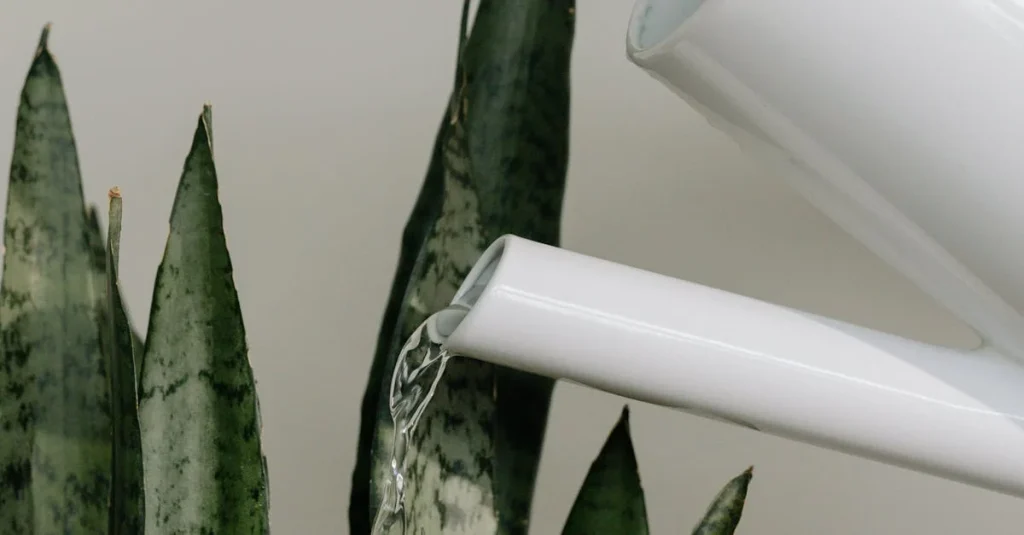Snake plants, also known as Sansevieria or Mother-in-Law’s Tongue, are some of the most resilient houseplants you can own. Their striking, upright leaves and low-maintenance nature make them a favorite for beginners and seasoned plant parents alike. However, even these hardy plants need proper care, especially when it comes to watering. In this guide, we’ll walk you through everything you need to know about watering snake plant to ensure it stays healthy and vibrant.
Why Watering Snake Plants Matters?
Snake plants are succulents, meaning they store water in their thick, fleshy leaves. This adaptation allows them to survive in arid conditions, making them drought-tolerant. However, improper watering—either too much or too little—can lead to problems like root rot or dehydration. Understanding their unique needs will help you strike the perfect balance.
How Often Should You Water a Snake Plant?
The frequency of watering depends on several factors, including light, temperature, humidity, and the plant’s environment. As a general rule:
- Water every 2–6 weeks: Snake plants typically need water every 2–4 weeks in spring and summer (their growing season) and every 4–6 weeks in fall and winter (when growth slows).
- Check the soil: Always let the soil dry out completely between waterings. Stick your finger about an inch into the soil; if it feels dry, it’s time to water.
- Adjust for conditions: Plants in bright, indirect light or warmer rooms may need slightly more frequent watering, while those in low light or cooler areas require less.
Signs Your Snake Plant Needs Water
- Leaves start to wrinkle or feel soft.
- Soil is bone-dry and pulling away from the pot’s edges.
- Tips of leaves turn brown or crispy.
Signs of Overwatering
- Yellowing or mushy leaves.
- Soft, soggy base or stems.
- Foul odor from the soil, indicating root rot.
How to Water a Snake Plant Properly
Follow these steps to ensure your snake plant gets the right amount of water:
- Choose the Right Pot and Soil
Snake plants thrive in well-draining soil, such as a cactus or succulent mix. Ensure the pot has drainage holes to prevent water from pooling at the bottom, which can lead to root rot. - Water Thoroughly but Infrequently
When watering, pour water evenly around the soil until it starts to drain from the bottom. Discard any excess water from the saucer to avoid soggy roots. Less frequent, deep waterings are better than small, frequent sips. - Avoid Getting Water on the Leaves
Water trapped in the center of the rosette (where leaves meet the base) can cause rot. Aim to pour water directly onto the soil. - Consider the Season
In spring and summer, your snake plant may need slightly more water to support growth. In fall and winter, reduce watering as the plant enters a dormant phase.

Factors That Affect Watering Needs
Several environmental factors influence how often your snake plant needs water:
- Light: Snake plants in bright, indirect light use water faster than those in low light.
- Temperature: Warmer temperatures increase evaporation, so plants in hotter climates or rooms may need more frequent watering.
- Humidity: Low humidity can dry out the soil faster, while high humidity slows evaporation.
- Pot Size and Type: Smaller pots dry out faster, while larger pots retain moisture longer. Terracotta pots allow more evaporation than plastic or ceramic ones.
Common Watering Mistakes to Avoid
- Overwatering: This is the leading cause of snake plant problems. Always err on the side of underwatering, as these plants are built to handle drought.
- Using a Pot Without Drainage: Trapped water can suffocate roots and lead to rot.
- Watering on a Fixed Schedule: Instead of watering weekly, check the soil’s dryness to determine when it’s time.
- Ignoring Signs of Stress: Yellowing leaves or a soggy base are cries for help. Adjust your care routine promptly.
Troubleshooting Snake Plant Watering Issues
- Yellow Leaves: Usually a sign of overwatering. Check the soil and reduce watering frequency. If the base feels mushy, inspect for root rot and repot if necessary.
- Wrinkled Leaves: Indicates underwatering. Give the plant a thorough drink and monitor soil dryness moving forward.
- Brown Tips: Often caused by inconsistent watering or low humidity. Trim the brown tips with clean scissors and adjust your watering routine.
Bonus Tips for Snake Plant Care
- Light: Snake plants tolerate a wide range of light conditions, from low to bright indirect light. Avoid direct sunlight, which can scorch leaves.
- Fertilizing: Feed sparingly with a diluted, balanced fertilizer (e.g., 10-10-10) once or twice during the growing season. Overfertilizing can harm the plant.
- Cleaning: Wipe dust off the leaves with a damp cloth to keep them healthy and shiny.
- Repotting: Repot every 2–3 years or when the plant becomes root-bound, using fresh, well-draining soil.
Conclusion
Watering a snake plant is simple once you understand its needs. By allowing the soil to dry out between waterings, using a well-draining pot, and paying attention to environmental factors, you can keep your snake plant thriving for years. With minimal effort, this hardy houseplant will reward you with its bold, architectural beauty.
Happy planting!



